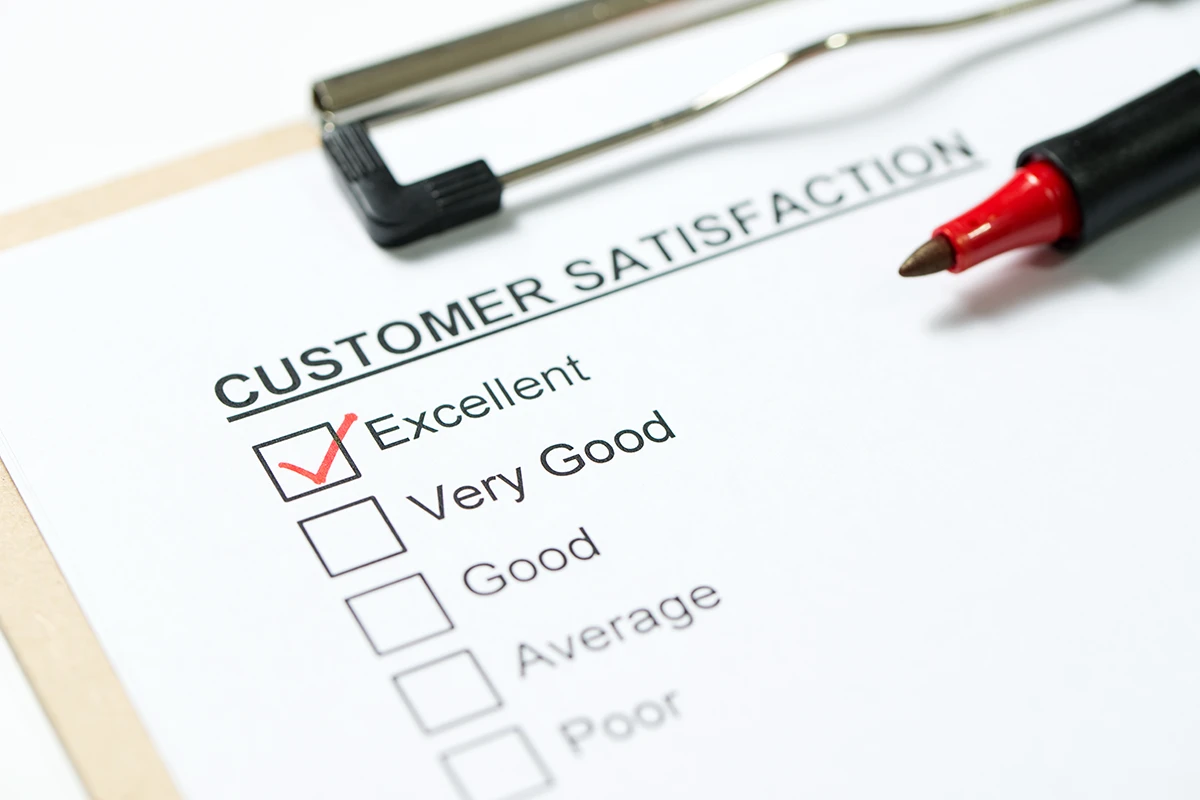How to Improve Customer Satisfaction for Service-Based Businesses
Discover the trick to improving customer satisfaction in your service-based business

Improving customer satisfaction is one of the most effective ways to increase customer retention and turn a one-off sale into recurring revenue. Considering it’s estimated that acquiring a new customer can cost up to five times more than retaining an existing one, it’s essential not to waste any opportunity to impress.
With that in mind, here are fourteen ways to improve customer satisfaction in your service-based business.
1. Train and empower your employees
For service-based businesses, in particular, the quality of your employees has a direct impact on customer satisfaction. Therefore, it’s essential to provide comprehensive training to all your employees to ensure they have the skills and knowledge necessary to provide high-quality services to customers.
Training should be ongoing, with refresher courses throughout the year to introduce new methods and maintain standards.
2. Collect (and listen to) customer feedback
Another simple way to improve customer satisfaction is to ask for customer feedback and take action on suggestions or complaints. Being proactive about requesting feedback can help you better understand your customers' needs and preferences. The feedback you collect can then be used to make data-driven improvements to your services and operating procedures like booking methods and payments.
Effective ways to collect customer feedback include
- Surveys
- Reviews
- Direct conversations
- Polls
3. Set clear expectations for both customers and employees
Ensuring customers clearly understand what to expect regarding quality, response times, and pricing can help improve customer satisfaction. Clear expectations help to avoid situations where you over-promise and under-deliver and ensure customers know what they’re signing up for.
For example, if your plumbing company doesn’t have the resources to provide round-the-clock emergency callouts, you should make it clear on your website that you only operate between 8 a.m. and 5 p.m.
When setting expectations, consider what might be “the norm” in your industry and, therefore, expected by customers (such as emergency callouts for our fictional plumbing company). If your business can provide XYZ, call it out. Similarly, call it out if you know it’s commonplace, but your business cannot accommodate specific requests. That way, no one feels misled.
While you’re in the process of setting expectations, it’s essential to also set expectations with your employees around things like availability, service quality, punctuality, etc., which can also impact customer satisfaction.
4. Personalize your customer experience
90% of customers spend more with businesses that personalize the customer experience. If you’re looking to improve customer satisfaction and your sales figures, personalizing the customer experience is a good way to do it.
In order to personalize your customer experience, you need to know what makes your customers tick. What pain points do they have that your business solves, how do they prefer to contact service businesses like yours (hint, it’s almost always through online booking!), etc? You can use this customer research to tailor your services and the way you communicate.
Implementing a customer relationship management (CRM) tool is useful for keeping track of customer information and interactions. Tools like MarketBox enable you to add notes to a customer’s profile so you can store information like service preferences, allergies, and other important notes to provide a seamless repeat experience.
5. Improve communication
Another effective way to improve customer satisfaction is to make it easier for customers to reach your business through their preferred method of communication. However, it’s vital that you’re able to provide timely responses to inquiries and address concerns quickly, so if you don’t have the resources to monitor them, don’t overwhelm your team by introducing multiple communication channels across social media, phone, email, web chat, etc.
6. Streamline processes to reduce delays
One of the biggest causes of customer dissatisfaction is lengthy delays. Optimizing your business processes effectively reduces wait times and scheduling errors that can impact how quickly your customer can receive their desired service.
Investing in technology for your business that can help automate and simplify processes is the easiest way to streamline. A booking and scheduling tool like MarketBox can handle customer booking, employee scheduling, payments, time-tracking, automated appointment reminders, and more, so you can provide faster, more efficient services.
7. Focus on consistency
While most businesses know the importance of providing a consistent service to customers, only some consider the entire customer experience. To improve customer satisfaction, you must maintain a consistently high-quality service across every stage of the customer journey, from initial inquiry and booking to the service and after-care.
To maintain consistency, implement standardized protocols that all employees must follow to ensure customers receive the best service possible.
8. Resolve issues quickly and effectively
Even after taking steps to improve customer satisfaction, issues will still arise. How your team is trained to handle them, however, can be the difference between customer loyalty and driving them to a competitor. Implement a clear and efficient process for handling customer complaints so employees have a framework to follow as/when an issue arises.
It’s also important for service-based businesses to empower employees to make decisions and resolve issues without needing to escalate the problem to management, as this can reduce the number of customer service requests your team deals with and ensures any issues that arise are dealt with promptly.
9. Introduce loyalty programs and incentives
Loyalty programs are an effective way to make customers feel valued and increase satisfaction. To encourage repeat business, consider implementing a loyalty program that rewards repeat customers with discounts, exclusive offers, or points toward future services.
While setting up your loyalty program, consider adding referral bonuses to encourage word-of-mouth referrals.
10. Invest in your business’s online presence
Nearly half of all consumers expect a web page to load in two seconds or less, and since 82% of clients use mobile devices to book appointments, a good online presence is essential. Invest in a user-friendly website and ensure your key information is easily accessible. If it’s relevant to your target market and industry, maintain an active social media presence. And don’t neglect your Google Business Profile!
Related: How to increase organic website traffic for in-home service businesses
11. Benchmark against competitors
A little competition is healthy in business, so keep an eye on what other businesses in your area are doing regarding customer service and take steps to outperform them!
Set your business apart by highlighting what makes your company unique and draw attention to superior service elements and five-star customer reviews.
12. Monitor key performance indicators
If you’re in the process of improving customer satisfaction, the only way to know if the steps you’re taking are working is to track them. Use key performance indicators (KPIs) to track customer satisfaction and service quality and review them regularly to identify areas for improvement.
Metrics to track include
- Customer satisfaction score (CSAT)
- Customer effort score (CES)
- Number of customer service tickets
- Response time to complaints
- Churn rate
- Retention rate
13. Create a positive company culture
Happy and engaged employees are more likely to provide high-quality services, which in turn creates happy and satisfied customers. So, to improve customer satisfaction, it’s important to look inward at your company culture, too.
Foster a positive company culture that values employees, encourages open communication, provides competitive compensation, and rewards top-performing employees. Rewarding employees for their dedication and accomplishments not only boosts morale but also contributes to a motivated and engaged workforce.
Set clear expectations around performance and provide training to help employees meet those goals and expectations.
14. Innovate and evolve with changing customer preferences
Lastly, service-based businesses that want to improve customer satisfaction need to innovate and be prepared to adapt as customer needs and industry trends change. Therefore, it’s important that customer-focused businesses continuously look for ways to improve their services and how they are delivered.
Final thoughts
Improving customer satisfaction is an ongoing process that requires dedication and a customer-centric approach. By implementing the strategies outlined above, service businesses can enhance their reputation, build customer loyalty, and drive growth.
Ready to transform your scheduling?
Talk to our sales team and see how MarketBox can help you achieve more with less effort




.svg)

